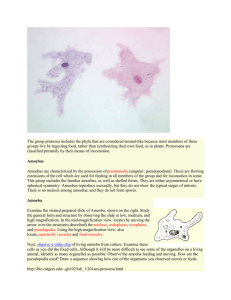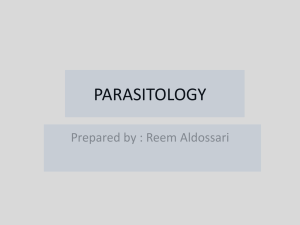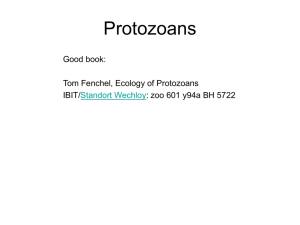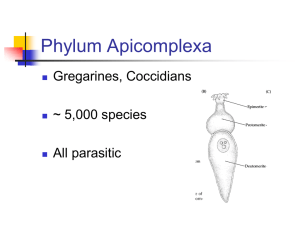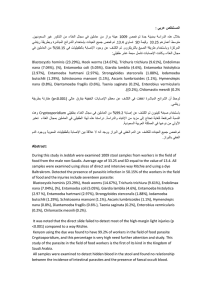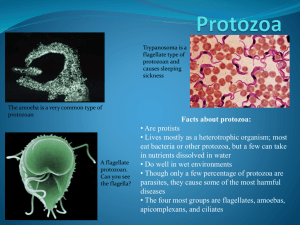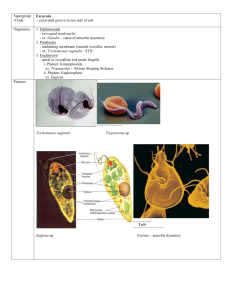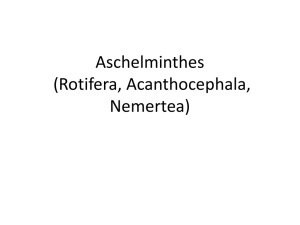Amoebozoa simon - Dsapresents.org
advertisement
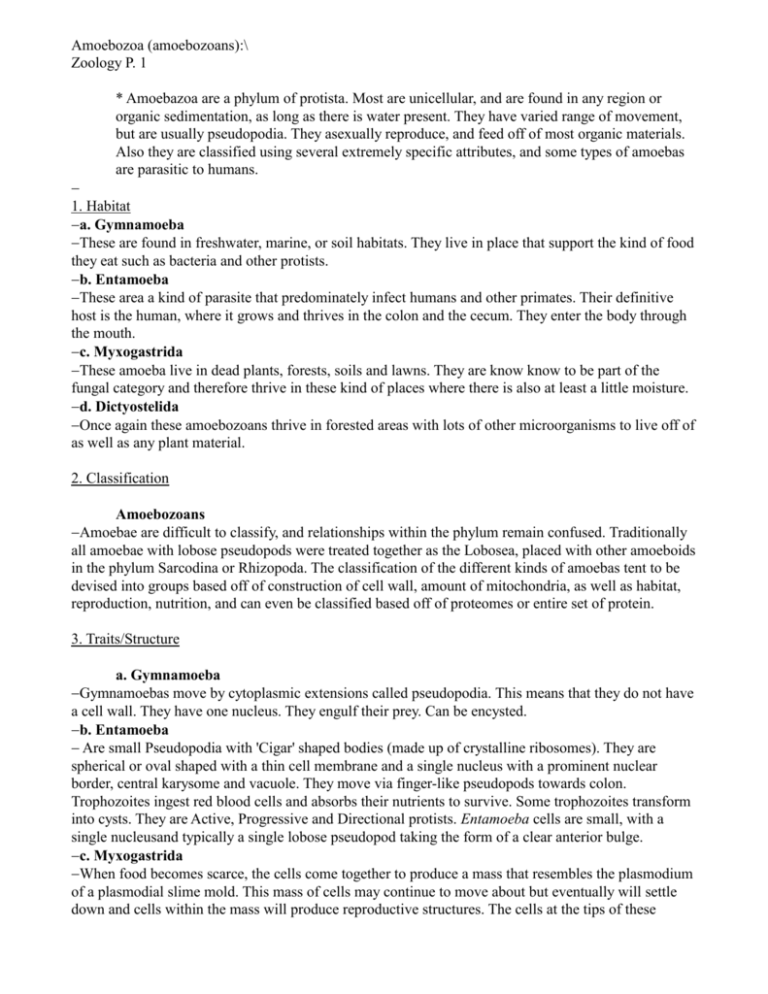
Amoebozoa (amoebozoans):\ Zoology P. 1 * Amoebazoa are a phylum of protista. Most are unicellular, and are found in any region or organic sedimentation, as long as there is water present. They have varied range of movement, but are usually pseudopodia. They asexually reproduce, and feed off of most organic materials. Also they are classified using several extremely specific attributes, and some types of amoebas are parasitic to humans. 1. Habitat a. Gymnamoeba These are found in freshwater, marine, or soil habitats. They live in place that support the kind of food they eat such as bacteria and other protists. b. Entamoeba These area a kind of parasite that predominately infect humans and other primates. Their definitive host is the human, where it grows and thrives in the colon and the cecum. They enter the body through the mouth. c. Myxogastrida These amoeba live in dead plants, forests, soils and lawns. They are know know to be part of the fungal category and therefore thrive in these kind of places where there is also at least a little moisture. d. Dictyostelida Once again these amoebozoans thrive in forested areas with lots of other microorganisms to live off of as well as any plant material. 2. Classification Amoebozoans Amoebae are difficult to classify, and relationships within the phylum remain confused. Traditionally all amoebae with lobose pseudopods were treated together as the Lobosea, placed with other amoeboids in the phylum Sarcodina or Rhizopoda. The classification of the different kinds of amoebas tent to be devised into groups based off of construction of cell wall, amount of mitochondria, as well as habitat, reproduction, nutrition, and can even be classified based off of proteomes or entire set of protein. 3. Traits/Structure a. Gymnamoeba Gymnamoebas move by cytoplasmic extensions called pseudopodia. This means that they do not have a cell wall. They have one nucleus. They engulf their prey. Can be encysted. b. Entamoeba Are small Pseudopodia with 'Cigar' shaped bodies (made up of crystalline ribosomes). They are spherical or oval shaped with a thin cell membrane and a single nucleus with a prominent nuclear border, central karysome and vacuole. They move via finger-like pseudopods towards colon. Trophozoites ingest red blood cells and absorbs their nutrients to survive. Some trophozoites transform into cysts. They are Active, Progressive and Directional protists. Entamoeba cells are small, with a single nucleusand typically a single lobose pseudopod taking the form of a clear anterior bulge. c. Myxogastrida When food becomes scarce, the cells come together to produce a mass that resembles the plasmodium of a plasmodial slime mold. This mass of cells may continue to move about but eventually will settle down and cells within the mass will produce reproductive structures. The cells at the tips of these structure become spores. The spores then germinate when conditions become favorable. They use pointed pseudopodia for movement and for capturing food. Myxogastria have diploid nuclei. These organisms are pigmented with bright colors. In the plasmodium stage, Myxogastria are covered by a membrane, but is not enclosed in a cell wall. They are heterotrophic. d. Dictyostelida Considered to be fungal. Dictyostelium are able to alternate between unicellular and multicelluar forms. There are no cell walls on these organisms. Individual cells are not flagellated, and thus are largely non-motile. These individual cells eventually aggregate by sliding. The cytoplasm projects to form a pseudopod, allowing the organism to travel. Dictyostelium adapts to changes in environment. In response to elevated temperatures, Dictyostelium change their fatty acid composition to maintain membrane fluidity. 4. Reproduction/Life Cycle a. Gymnamoeba These protists reproduce by binary fission. This is where A living cell divides into two cells. The two cells should be identical. This process is basically when a prokaryotic organism divides into two parts. The parent cell divides to give rise to two daughter cells, the daughter cells then each develop into individual parent cells and give rise to two more daughter cells each, and so on and so forth. b. Entamoeba Also use asexual reproduction to reproduce. Same as Gymnamoeba. c. Myxogastrida Spores are resistant to environmental extremes and germinate when environmental conditions become favorable. They germinate to produce haploid cells that are either biflagellate (two flagella) or amoeboid. These cells can act as gametes, fusing to produce a diploid zygote that matures into the plasmodium. d. Dictyostelida The amoeboid cells are haploid. In the sexual phase of the life cycle, two amoeboid cells fuse to form a zygote. New amoeboid cells are produced by meiosis. 5. Nutrition a. Amoebazoans Amoebas food consist of Oscilatoria, Diatom, Rotifers, bacteria, flagellates, Peramecium, Daphinia, Cyclope. They may also feed on dead organic material. Any of the eukaryota in the phylum amoebozoa feed off of any organic material found in its habitat... Makes sense! 6. Parasites a. Entamoebas There are six kinds of parasitic amoebas. Entamoebas are a parasitic class of the phylum amoebazoans. Within this class there are several subclasses that define specific parasitic amoebas. Entamoeba histolytica is, possibly, the most pathogenic amoeba for humans. Humans are the primary host for this pathogen. It is spread via the anal to oral route. It is usually acquired from contaminated water, or from foodstuffs contaminated by untreated sewage. Entamoeba histolytica causes amoebic dysentery,
